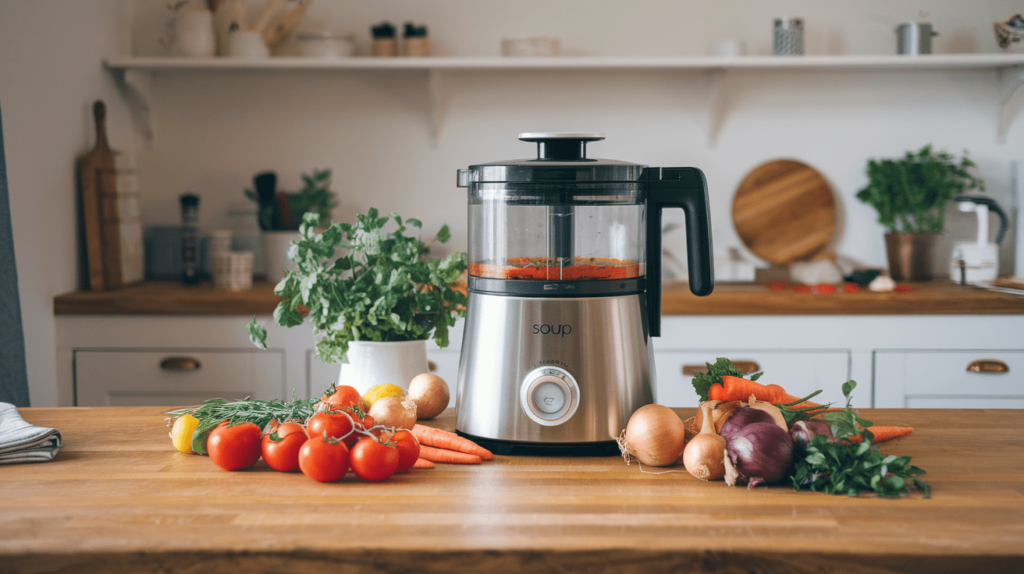Soup lovers know there’s nothing quite like a warm, comforting bowl of soup, especially when it’s homemade. But who has hours to spend slaving over a pot in the kitchen? Enter the soup maker, your ultimate kitchen sidekick. With it, you can whip up quick and easy homemade soups that taste like they simmered all day—without the hassle. This article will be your go-to guide for delicious soup maker recipes, tips, and creative twists to make every bowl of soup better than the last.
Introduction to Soup Maker Recipes
Imagine this: It’s a chilly evening, and all you want is a piping hot bowl of soup to warm you from the inside out. But you’re too exhausted to stand in front of the stove, stirring, blending, and hoping you don’t burn the bottom. That’s where a soup maker comes in. It’s the superhero of soup lovers—combining ease, speed, and flavor in one compact appliance.
A soup maker isn’t just another kitchen gadget. It’s a game-changer. Whether you’re craving a chunky vegetable soup, creamy tomato goodness, or a hearty chicken broth, soup makers do all the heavy lifting for you. Toss in your ingredients, set it, and go about your business while it cooks, blends, and keeps your soup warm.
But what makes soup makers so popular? Well, they’re versatile, easy to use, and save both time and energy. Plus, they make homemade soups accessible even to those who claim they can’t cook. This article will walk you through the benefits, essential ingredients, and some drool-worthy recipes you’ll want to try immediately.
Benefits of Using a Soup Maker for Homemade Soups
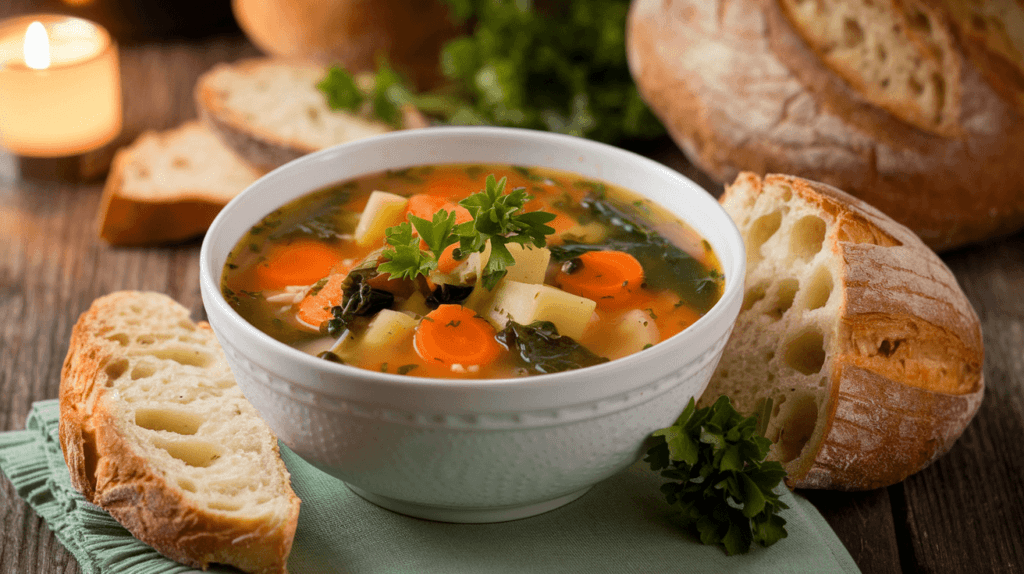
If you’re still on the fence about getting a soup maker, let’s break down why it’s worth the investment.
Save Time and Effort
The biggest selling point of a soup maker is its convenience. Unlike traditional soup-making methods, you don’t have to monitor the pot constantly. Simply add your chopped ingredients, select the setting (smooth or chunky), and let the machine do its thing. In as little as 20 minutes, your soup will be ready.
Consistent Results Every Time
Ever made a soup that turned out too thick, too thin, or just plain bland? A soup maker eliminates guesswork. It blends ingredients evenly, cooks everything at the right temperature, and ensures you get the perfect consistency every time.
Less Washing Up
Who likes cleaning multiple pots, pans, and blenders? With a soup maker, it’s one pot, one blade, and that’s it. Most models even come with a self-cleaning function, so you don’t have to scrub or soak stubborn stains.
Healthy and Nutritious
Making soup at home means you control what goes in—no preservatives, added sugars, or unnecessary fats. It’s a great way to load up on vegetables, lean proteins, and superfoods while keeping things light and healthy.
Perfect for Busy Lives
For busy parents, students, or professionals, soup makers are a lifesaver. You can prep ingredients the night before, toss them in the machine the next day, and come home to a warm, comforting meal.
Essential Ingredients for Soup Maker Recipes
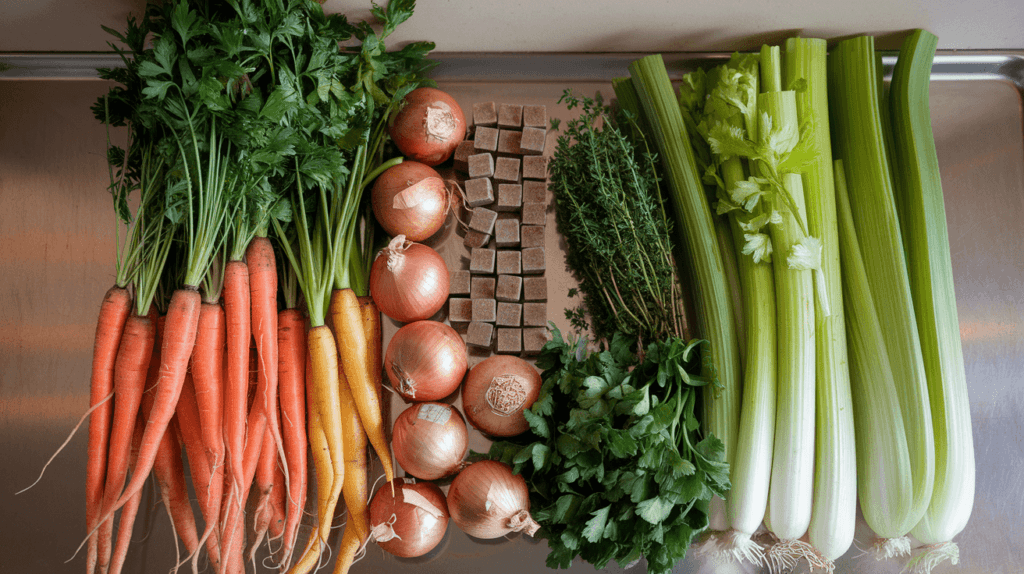
Before diving into recipes, let’s talk about the must-have ingredients for any homemade soup.
Fresh Vegetables for Soup Maker Recipes
Fresh veggies are the heart and soul of any good soup. Think carrots, celery, onions, potatoes, tomatoes, and leeks. Leafy greens like spinach, kale, or cabbage are also great for boosting nutrition. If you’re short on time, frozen vegetables work just as well and can be added directly to the soup maker.
Stock and Seasonings: The Backbone of Any Soup
Stock or broth forms the base of your soup. You can use chicken, beef, vegetable, or even bone broth, depending on the recipe. For a quick and easy option, stock cubes work fine too.
Seasonings are where you can get creative. Salt and pepper are a given, but don’t stop there. Add herbs like thyme, rosemary, and parsley for an earthy taste. Spice it up with paprika, cumin, or chili flakes if you like a kick.
Proteins for Heartier Soups
If you want your soup to be more filling, add proteins like shredded chicken, beef chunks, lentils, chickpeas, or beans. These ingredients turn a light soup into a satisfying, full meal.
Cream and Dairy Options
For creamy soups like tomato or leek and potato, a splash of cream, milk, or Greek yogurt works wonders. For dairy-free options, coconut milk or almond milk gives a rich, silky texture.
Popular Soup Recipes for Soup Maker
Here comes the fun part—recipes! These soup maker recipes are not only quick and easy but also guaranteed to please any palate.
Classic Vegetable Soup Recipe for Soup Maker
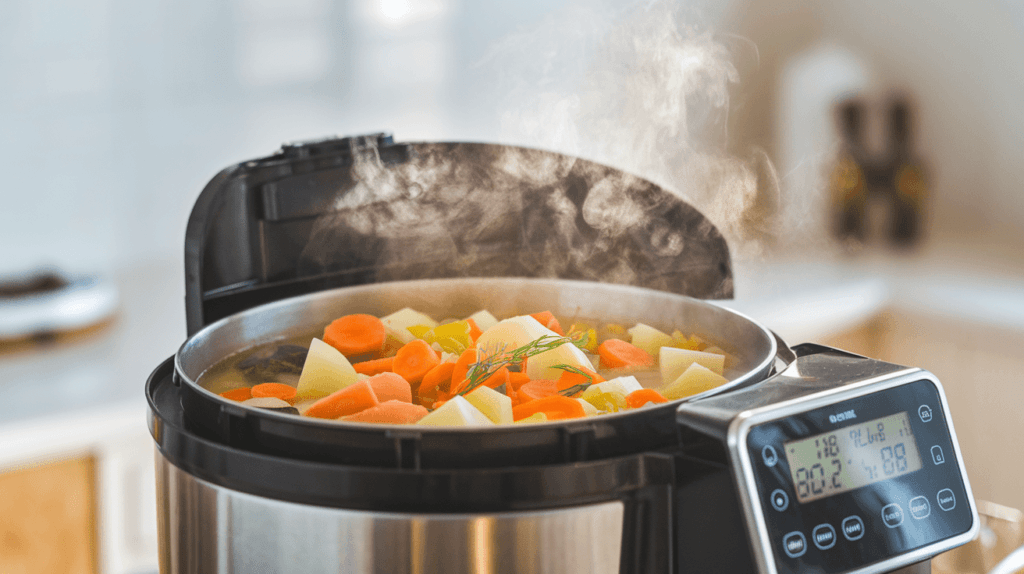
Ingredients:
- 2 carrots, diced
- 2 celery sticks, chopped
- 1 onion, finely diced
- 1 potato, peeled and cubed
- 2 cloves garlic, minced
- 4 cups vegetable stock
- 1 tsp mixed herbs (thyme, parsley, basil)
- Salt and pepper to taste
Instructions:
- Add all the ingredients to the soup maker.
- Select the smooth or chunky setting, depending on your preference.
- Let the machine run its course. In 20 minutes, your soup will be ready.
- Serve hot with a slice of crusty bread.
If you’re looking to expand your soup repertoire, try something unique like a curry butternut squash soup. It’s the perfect blend of creamy texture with a hint of spice, making it ideal for cozy evenings. You can find a detailed recipe here to whip up this flavorful delight effortlessly. Not only is it quick, but it also packs plenty of nutrients from fresh butternut squash, perfect for a healthy yet indulgent meal.
Soup Maker Leek and Potato Soup: A Comforting Classic
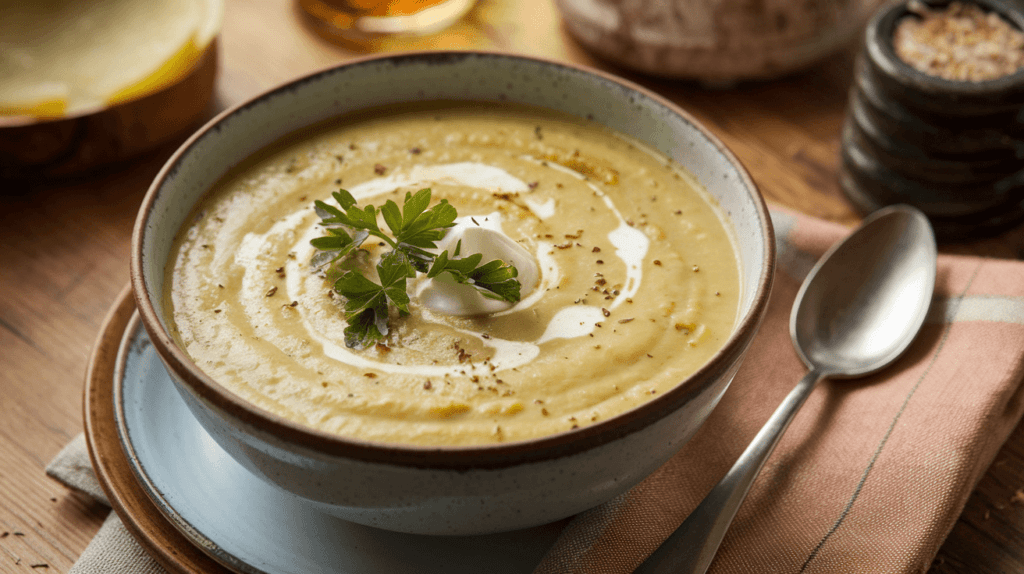
Ingredients:
- 2 leeks, washed and sliced
- 2 potatoes, peeled and chopped
- 1 onion, diced
- 2 cloves garlic, minced
- 3 cups chicken or vegetable stock
- 1/2 cup heavy cream (optional)
- Salt and pepper to taste
Instructions:
- Place leeks, potatoes, onions, garlic, and stock into the soup maker.
- Select the smooth setting.
- When done, stir in the cream for extra richness. Season with salt and pepper.
- Serve piping hot and enjoy the velvety goodness.
Soup maker leek and potato soup is the ultimate comfort food. It’s creamy, flavorful, and perfect for a chilly day.
Soup Maker Chicken Soup: Hearty and Nutritious
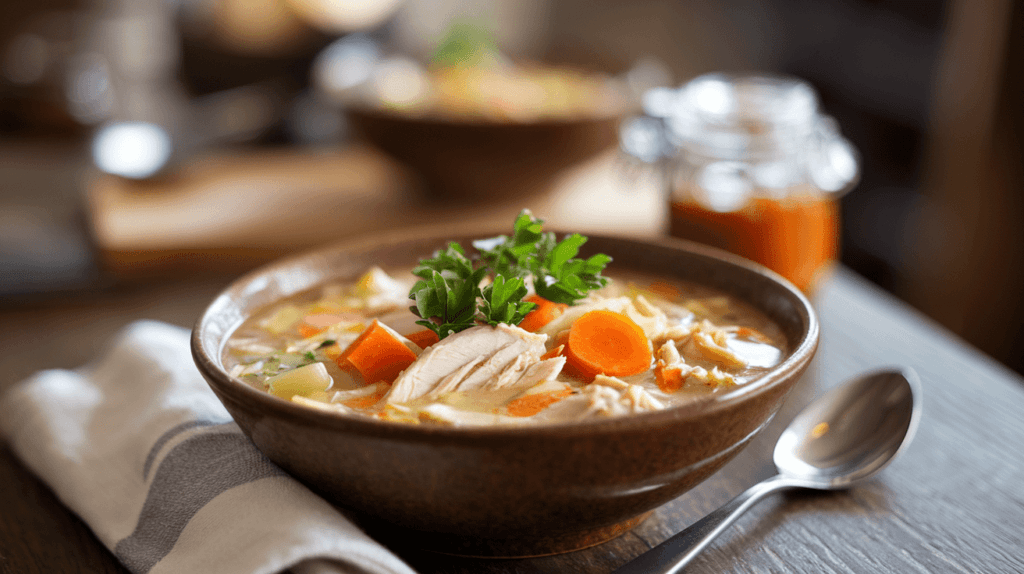
Ingredients:
- 1 chicken breast, diced
- 1 carrot, sliced
- 1 celery stalk, chopped
- 1 onion, finely diced
- 3 cups chicken stock
- 1 tsp dried thyme
- Salt and pepper to taste
Instructions:
- Add all the ingredients to the soup maker.
- Select the chunky setting for texture.
- Let the soup maker work its magic.
- Serve warm with a sprinkle of fresh parsley.
This soup maker chicken soup is perfect when you’re feeling under the weather. It’s hearty, nutritious, and guaranteed to warm your soul.
Quick Creamy Tomato Soup for Soup Maker
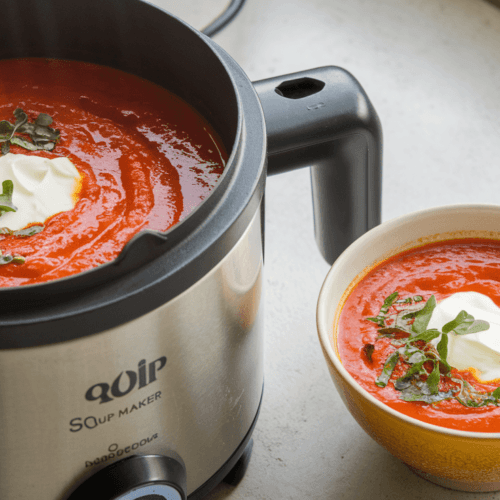
Quick Creamy Tomato Soup for Soup Maker
Ingredients
- 6 ripe tomatoes chopped
- 1 small onion chopped
- 2 cloves garlic minced
- 2 cups vegetable stock
- 1/2 teaspoon sugar optional, to balance acidity
- 1/2 teaspoon dried basil
- 1/4 teaspoon black pepper
- Salt to taste
- 1/2 cup heavy cream for creaminess
- 1 tablespoon olive oil
Instructions
Prepare the Ingredients:
- Chop the tomatoes, onion, and mince the garlic.
Cook the Soup:
- Add the tomatoes, onion, garlic, vegetable stock, sugar, dried basil, salt, and pepper to the soup maker. Close the lid and set it to the 'smooth soup' setting.
Finish with Cream:
- Once the soup is ready, pour in the heavy cream and stir well until fully incorporated. Adjust seasoning as needed.
Serve:
- Ladle the creamy tomato soup into bowls and serve warm. Optionally, drizzle with extra cream or garnish with fresh basil.
Notes
- Adjust Acidity: If the tomatoes are too tangy, add a bit of sugar to balance the flavor.
- Optional Spice: Add a pinch of chili flakes for a spicy kick.
- Storage: The soup can be refrigerated for up to 3 days or frozen for later use.
- Dietary Options: Replace heavy cream with coconut milk for a dairy-free version.
This creamy tomato soup is a crowd-pleaser and pairs perfectly with a gooey grilled cheese sandwich.
How to Customize Soup Maker Recipes
One of the most fantastic things about a soup maker is its versatility. Whether you’re in the mood for a thick, hearty soup or a light, smooth broth, you can easily customize your recipes to suit your taste and dietary preferences. Let’s explore how you can tweak your soup recipes for the perfect bowl every time.
Adjusting Texture: Smooth vs Chunky Soups
Not everyone likes the same texture when it comes to soups. Some prefer a creamy, silky consistency, while others enjoy a chunky, rustic bite. Luckily, most modern soup makers come with two settings—smooth and chunky—to cater to both preferences.
- For smooth soups: Use soft vegetables like tomatoes, potatoes, or butternut squash. These blend beautifully and create a velvety texture. Adding cream or coconut milk at the end enhances the smoothness.
- For chunky soups: Combine firm vegetables like carrots, celery, and beans with proteins like chicken or lentils. Set the soup maker to the chunky setting, and you’ll get a rich, textured bowl of goodness.
Quick Tip: If your soup is too thick, just add a little extra stock or water and blend briefly. For thin soups, add a handful of cooked potatoes or lentils to thicken things up.
Adding Protein: Meat, Beans, and Legumes
Want to turn your soup into a complete meal? Add protein! Soup is a great vehicle for nutritious proteins that leave you feeling full and satisfied.
- Meat options: Add diced chicken, turkey, or even cooked beef. Chicken breast works particularly well in the soup maker chicken soup, as it cooks quickly and shreds beautifully.
- Legumes: Lentils, chickpeas, and kidney beans are perfect for vegetarian soups. They provide a hearty texture and a boost of plant-based protein.
- Seafood: Try shrimp, cod, or salmon for a twist. Add seafood toward the end of cooking to prevent it from getting rubbery.
Adding protein also makes soups kid-friendly, as it transforms them into a filling main meal.
Using Herbs, Spices, and Aromatics for Flavor Boosts
Herbs and spices are what make soups sing. Without them, soups can feel flat and boring.
- Classic herbs: Thyme, parsley, rosemary, and bay leaves are perfect for savory soups.
- Spices: Paprika, cumin, coriander, and turmeric work wonders for adding warmth and depth.
- Aromatics: Garlic, onions, leeks, and ginger add layers of flavor and are must-haves in most recipes.
Don’t be afraid to experiment. For example, in your vegetable soup recipe for a soup maker, adding a pinch of smoked paprika or a splash of balsamic vinegar can completely transform the dish.
For those who love bold flavors, don’t stop at traditional seasonings—explore unique spice blends to elevate your soups. Inspired by what makes dishes like Crown Fried Chicken unique, you can experiment with paprika, cumin, or even a touch of garam masala. Adding such spices not only brings warmth and depth to your soups but also transforms a simple meal into something extraordinary.
Adding Dairy or Dairy-Free Alternatives
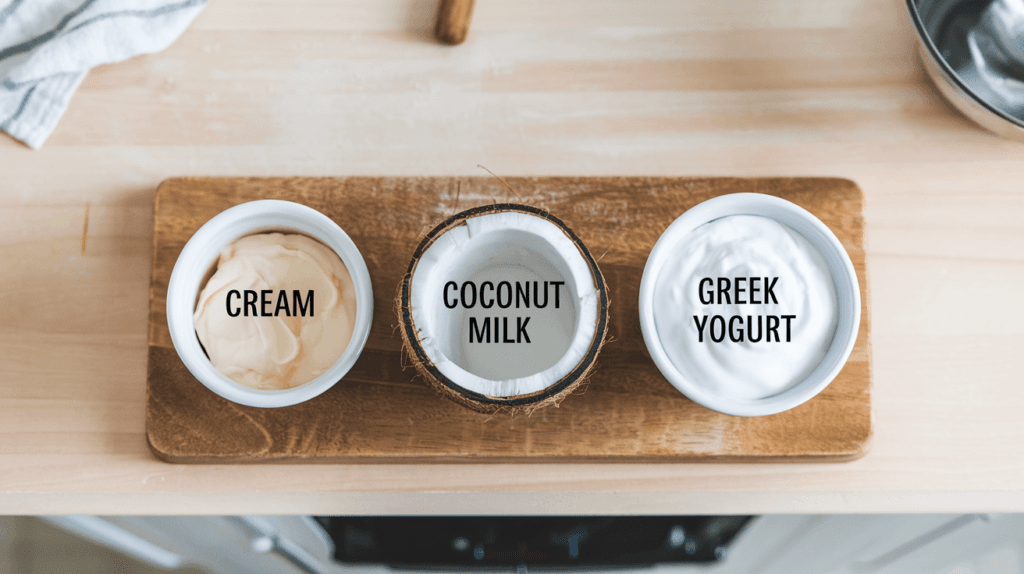
Creamy soups are a favorite for many, and adding dairy (or alternatives) can enhance texture and flavor.
- Dairy options: Heavy cream, milk, yogurt, or even cream cheese can be stirred in at the end. For soups like soup maker leek and potato soup, a swirl of cream turns it into pure luxury.
- Dairy-free options: Coconut milk, almond milk, or cashew cream are excellent vegan alternatives that add creaminess without the dairy.
For those watching their calorie intake, Greek yogurt is a lighter option that still gives soups a luscious texture.
Soup Maker Tips and Tricks for Perfect Results
While soup makers are relatively foolproof, there are still a few tricks to ensure your soups always come out restaurant-quality.
Choosing the Right Ingredients for the Best Flavor
- Use fresh ingredients whenever possible: Fresh vegetables, herbs, and proteins deliver the best flavor. However, frozen vegetables are a convenient alternative and work well in most recipes.
- Sauté aromatics first: For deeper flavor, briefly sauté onions, garlic, and spices in a pan before adding them to the soup maker.
- Layer your flavors: Add ingredients in stages if your soup maker allows it. For instance, start with stock and veggies, then add proteins or cream later.
Ideal Cooking Times for Different Types of Soups
Most soup makers can whip up soup in about 20-30 minutes, depending on the recipe. Here’s a quick guide to cooking times:
| Soup Type | Cooking Time |
|---|---|
| Vegetable Soups | 20-25 minutes |
| Chicken or Meat-Based Soups | 25-30 minutes |
| Lentil or Bean Soups | 25 minutes |
| Creamy Soups | 20 minutes (blend well) |
If your soup maker has a keep-warm function, use it to serve soup piping hot without overcooking it.
Preventing Burning at the Base of the Soup Maker
Burning can occasionally happen if thick ingredients stick to the bottom. To avoid this:
- Add enough liquid: Always ensure there’s sufficient stock or water to cover the ingredients.
- Stir ingredients first: Give everything a quick mix before turning on the soup maker.
- Avoid starchy overload: Too many potatoes, lentils, or rice can thicken soup excessively and cause burning.
Common Problems with Soup Makers and How to Solve Them
No kitchen gadget is perfect, and soup makers are no exception. Here are some common issues and how to fix them:
Soup is Too Thick or Thin
- Too thick: Add a splash of stock, water, or milk and blend briefly.
- Too thin: Add cooked potatoes, beans, or lentils, and blend to thicken.
Overcooked or Undercooked Ingredients
- Cut vegetables into similar-sized pieces for even cooking.
- Use fresh vegetables whenever possible, as they cook faster and retain their texture.
Preventing Burning at the Base
As mentioned earlier, ensure your soup has enough liquid. Avoid using overly starchy vegetables without balancing them with stock.
Additional Uses for Your Soup Maker Beyond Soups
Soup makers aren’t limited to soups alone. In fact, they’re incredibly versatile and can be used for a variety of recipes.
Smoothies and Shakes: Breakfast in Minutes
A soup maker is a surprisingly versatile appliance, perfect not only for soups but also for other creative meals. If you enjoy outdoor cooking or quick meals, don’t miss exploring Blackstone recipes. Combining your soup maker with these ideas can help you whip up shakes, sauces, or even a post-campfire smoothie—giving you more reasons to keep this kitchen tool at the center of your culinary adventures.
Sauces and Dips: Versatile Options for Every Meal
Soup makers can whip up sauces like marinara, pesto, or even creamy Alfredo. They’re also great for dips like hummus or guacamole.
Baby Food: Fresh and Healthy Purees
For parents, soup makers are a lifesaver when it comes to preparing homemade baby food. Blend cooked vegetables or fruits into smooth, nutritious purees.
FAQs
What else can I use a soup maker for?
Apart from soups, you can use it for smoothies, sauces, dips, baby food, and even desserts like pureed fruit compotes.
What not to put in a soup maker?
Avoid using very thick or dry ingredients like too much rice, flour, or pasta without sufficient liquid. Also, avoid large, raw meat chunks, as they may not cook properly.
Do you put raw vegetables in a soup maker?
Yes, most soup makers can handle raw vegetables perfectly. Just chop them into smaller pieces for even cooking.
Can you use frozen vegetables in a soup maker?
Absolutely! Frozen vegetables are convenient and cook well in soup makers. There’s no need to thaw them beforehand.
Do you put hot or cold stock in a soup maker?
Cold stock works best. The soup maker heats the stock along with the other ingredients, so there’s no need to preheat it.
Conclusion
In the world of quick, healthy, and satisfying meals, soup maker recipes are a true game-changer. From classics like soup maker leek and potato soup to hearty options like soup maker chicken soup, there’s something for everyone. With a soup maker, you can explore endless possibilities, customize flavors, and create nourishing soups with minimal effort.
Not only does a soup maker save time, but it also helps you embrace healthier eating, reduce food waste, and enjoy cooking again. So why not give it a try? Start with the recipes we’ve shared here, and soon, you’ll be a soup-making pro, impressing family and friends with your culinary creations.
Here’s to warm, hearty bowls of soup that bring comfort, flavor, and nourishment to your table. Happy cooking!

